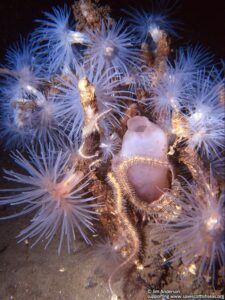Scotland’s Marine Protected Area (MPA) network is designed to provide place based protection to maintain representative habitats and species in good health, and in some cases support recovery, for rare, endangered and vulnerable habitats and species. All MPAs require unique management measures that provide protection to their identified features (habitat and/or species) from damaging activity, such as restricting demersal trawls and mechanical dredges from within sites or from zones within bigger sites. These management measures ensure MPAs meet their conservation objectives, and can impact marine users, such as changes to the location of fishing grounds, or increased opportunities for marine tourism. Monitoring the social, economic and ecological impacts and benefits of Scotland’s MPAs is essential to inform future management plans and ensure MPAs reach their conservation objectives.
In early 2016 Scottish Government introduced management measures that included restrictions on fishing activity within nine nature conservation Marine Protected Areas (MPAs) and 10 Special Areas of Conservation (SACs) in inshore waters. As fishing plays a key role in the economy, culture and society of coastal communities, parts of the fishing industry were concerned that these measures would negatively impact coastal communities and the livelihoods of fishermen.
One year down the line
As part of a long-term socio-economic monitoring strategy, a Marine Scotland report has found that in the first year since their introduction there was no evidence of significant socio-economic impact of the management measures, though it is possible marine sectors are still adjusting to the measures. This extends to the fishing industry, aquaculture activity, seafood processing, tourism or any other marine activity. At a local level, the report indicates that opportunities for coastal and marine tourism are increasing, and any losses from fishing grounds now within MPAs are being offset by a spatial shift in fishing activity to areas outside of MPAs. Similarly, a statistical analysis by Open Seas, found no significant negative impact of the MPA management measures on landed volume or value of scallops or Nephrops between January 2014 and November 2016 at the majority of key Scottish ports, though changes in market prices over this period may have influenced the quantity of stocks that this reflects. One year is not enough time to fully assess what economic impacts the management measures might have on activities in the MPA, however, the absence of evidence of significant negative impact to Scotland’s marine industries one year down the line is encouraging.
Broadening the monitoring strategy
There are many direct and indirect benefits provided by MPAs that cannot be measured in the same way as employment or fishing activity. By protecting the marine environment, MPAs can play an important role in supporting the culture, sense of identity, history and lifestyle of local communities. Additionally, those who value nature without directly benefitting from it, can support MPAs as a means to secure educational experiences and future fishing opportunities.
Well-managed MPAs can also provide many direct and indirect environmental benefits; such as  maintaining levels of biodiversity, allowing habitats and species to recover, increasing fish and shellfish size and quantity, and building resilience of marine ecosystems to external impacts such as climate change. A holistic scientific approach to monitoring the state of the marine environment will be essential to determine how effective MPA management measures are in both reaching their conservation objectives and in providing ecological and socio-economic benefits to our wider seas. The evidence gained from ecological monitoring can help to adapt and improve management measures in the future, and maximise the conservation potential of the protected area.
maintaining levels of biodiversity, allowing habitats and species to recover, increasing fish and shellfish size and quantity, and building resilience of marine ecosystems to external impacts such as climate change. A holistic scientific approach to monitoring the state of the marine environment will be essential to determine how effective MPA management measures are in both reaching their conservation objectives and in providing ecological and socio-economic benefits to our wider seas. The evidence gained from ecological monitoring can help to adapt and improve management measures in the future, and maximise the conservation potential of the protected area.
The spatial shift in fishing pressure to areas outside of MPAs and resultant impacts on fish and shellfish stocks should also be closely monitored to ensure this does not negatively impact the conservation objectives of the MPA network. Ecological monitoring presents a real opportunity for alleviating any socio-economic impacts that may arise further down the line, via collaboration between affected marine users and those tasked with developing science-based monitoring programmes.
As Scotland’s MPA network progresses, monitoring should be expanded to capture the full range of indirect and direct benefits, and seek to monitor any ecological changes and benefits. Such an approach must also be integrated with the monitoring and management of our wider seas.

